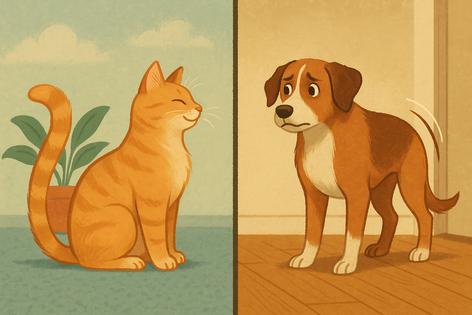Decoding Pet Body Language: What Your Cat and Dog Are Really Saying
Published in Cats & Dogs News
Pet owners often rely on meows, barks or tail wags to understand their companions, but animals communicate far more through posture, expression and subtle movements. For cats and dogs alike, body language is the first language — and learning to interpret it can transform the bond between people and their pets.
The Tail Tells the Tale
Perhaps the most recognized signal is a wagging tail, yet even here the nuances matter. For dogs, a broad, sweeping wag usually signals friendliness and excitement. A stiff, rapid wag held high, however, may mean arousal or even tension. A tucked tail signals fear or submission, while a neutral, gentle wag is a sign of calm contentment.
Cats use their tails differently. An upright tail often shows confidence, while a gently swishing tip can indicate curiosity. Rapid thrashing or lashing usually signals irritation, and a puffed tail is the feline version of a red alert — fear, anger or a defensive stance. Unlike dogs, cats’ tails rarely mislead; a careful glance at speed and angle reveals much about their mood.
Eyes and Ears Speak Volumes
In both species, eyes communicate as much as tails. Dogs that hold a soft gaze or slowly blink show relaxation and trust, while a hard stare with pupils narrowed may warn of defensiveness. Cats famously use the “slow blink” as a sign of affection. Owners who return the gesture often see their cats visibly relax, interpreting it as a nonverbal reassurance.
Ears add another layer. A dog’s ears perked forward signal alertness, while flattened ears may suggest fear or submission. Cats flatten their ears when angry or frightened, but swivel them when intrigued, listening intently to a sound. The key is context: ears alone don’t tell the whole story, but paired with tails and eyes, they become powerful cues.
Posture and Position
A dog that rolls onto its back is not always inviting a belly rub. Sometimes the posture signals trust, but in other cases it’s a submissive gesture asking for space. A stiff-legged stance with hackles raised is a clear sign of tension, while a loose, wiggly body usually points to playfulness.
Cats show mood in posture just as strongly. A relaxed cat might loaf with paws tucked under, while a crouched, tense body ready to spring signals unease. The classic arched back with raised fur is less common than cartoons suggest, but when it appears it almost always signals high stress.
Where pets choose to place themselves also tells a story. Dogs that lean into their owners, or cats that knead on a lap, are showing affection and comfort. Distance-seeking — moving behind furniture, hiding in corners — often points to fear, overstimulation or the need for quiet.
Sounds Are Secondary
Vocalizations get much of the attention, but experts agree that meows and barks are often secondary to body language. A dog that barks while bouncing in circles is inviting play, while a similar bark with a stiff stance and forward lean is a warning. Cats meow in countless tones, but it’s the accompanying posture — relaxed or tense — that reveals whether the sound is friendly or frustrated.
Why It Matters
Understanding these signals goes beyond curiosity. Misinterpreting a wagging tail or a roll onto the back can lead to unwanted bites or scratches. More importantly, recognizing fear or discomfort allows owners to adjust environments and interactions, building trust instead of stress.
Animal behaviorists emphasize patience: learning body language is a process of observing, comparing and remembering. Over time, patterns emerge, and each pet develops its own slight variations. A dog may invent a unique “play bow,” or a cat may flick its tail in idiosyncratic ways, but the broader language remains consistent.
The Bond Grows Stronger
For most owners, decoding body language deepens the human-animal connection. A soft blink exchanged with a cat or the recognition of a dog’s tentative lean turns ordinary moments into dialogue. It allows humans to respond with reassurance, respect boundaries, and celebrate joy on their pets’ terms.
The language of pets is not spoken, yet it is clear to those who watch closely. Every wag, blink and twitch is part of a conversation. And for those who learn to listen with their eyes, the reward is not only better understanding — it is a stronger bond built on trust.
========
This article was created, in part, utlizing AI tools









Comments